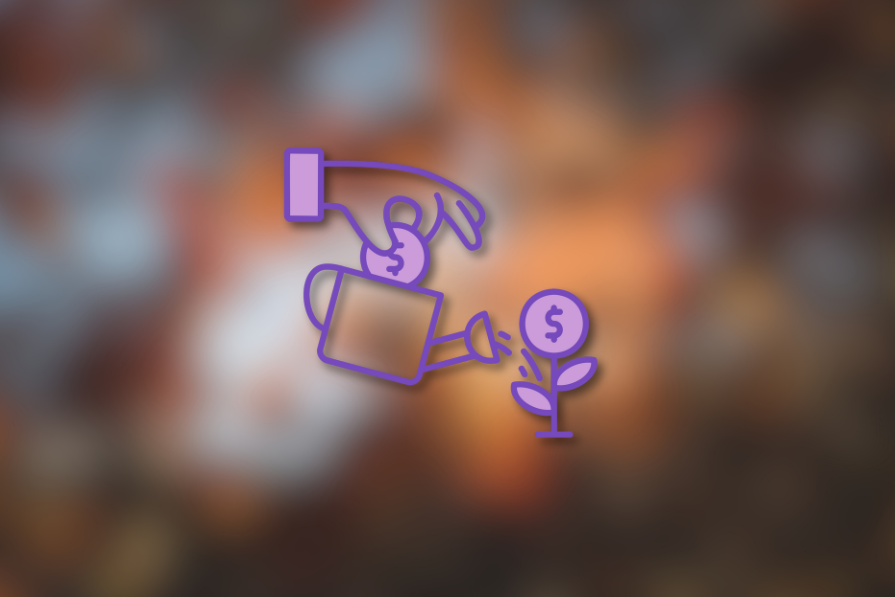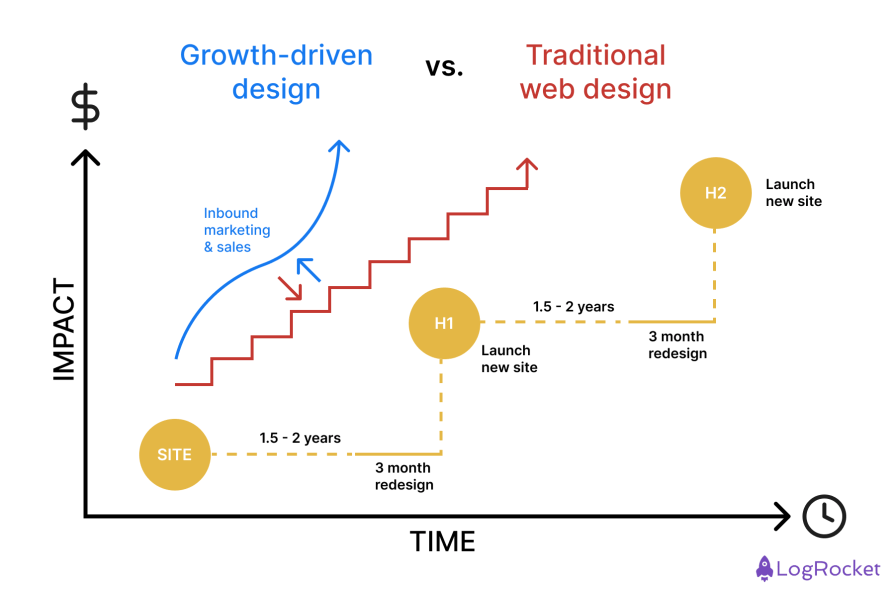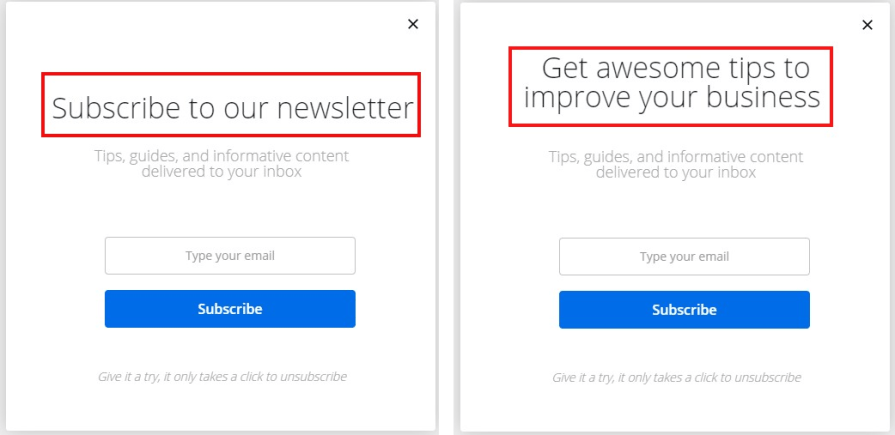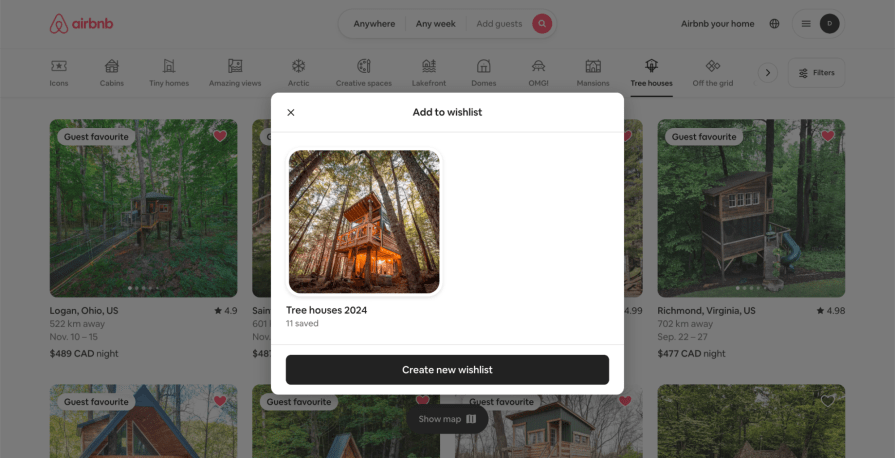The role of a UX designer has evolved significantly over the past decade. Or perhaps just how the industry segments and labels designers has changed. Today, we have UX designers, UI designers, visual designers, web designers, product designers, and now, growth designers.

In a world where everything runs on data, businesses are continuously investing in growth and optimization. A business that’s not growing is a dying business. And this evolution allows us, designers, to directly deliver business value by focusing on success metrics like conversion and retention.
In this article, I’ll discuss the importance of growth designers in UX, their role, how it differs from product design, and how they can impact business success.
In simple words, growth-driven design uses data to improve business outcomes.
Where traditional product design relies on using customer insights to solve problems and create innovative solutions, growth-driven design takes an iterative approach to conducting experiments. It is all about leveraging user behavior to improve business metrics, such as user engagement, conversion, and retention. Essentially, growth design blends various skills, including UX design, data analysis, marketing strategies, and experimentation.
The growth-driven design process has three main stages — strategy, launch, and continuous improvement. I’ll talk about these in detail now:
As with any design or business strategy, the process starts by identifying your goals. They could include certain metrics you want to improve across your business, such as customer lifetime value (LTV) or churn rates.
During this stage, you will need to connect with your users to hear their perspectives and formulate your strategy around the data you collect. Understand the pain points that users are looking to resolve with your product.
Your team can make tactical decisions supporting your goal by outlining a clear strategy.
After the strategy has been set, it’s time to launch an MVP to test your assumptions with users. Traditional product design may over-invest at this stage and take a longer timeframe to deliver improvements, but the key is to get something out quickly so that you can gather data and continuously improve upon it.
In the launch stage, you need to identify the key areas that can be improved with the lowest effort possible and deliver an iteration of your product based on assumptions.
The improvement stage is about monitoring your implementation, including using various analytics tools to gather quantitative data and using it to inform your next iteration.
This is where data drives decisions, giving you insights into the areas that need improvement and understanding whether or not your previous assumptions led to improvements in business metrics.
When making design decisions, think of finding questions like:
Continuous improvement is best done in short sprints, such as two-week intervals, to keep the feedback loop tight and deliver customer value often. Incremental changes to your designs will lead to optimized flows over time, which should ultimately have a positive impact on the business.

A growth designer collaborates with cross-functional team members, including engineers, data scientists, marketers, user researchers, and product managers, to bring new users into a product. This involves getting users started with the tools and support they need and creating experiences that help generate new revenue for the business.
Some crucial hard and soft skills that growth designers should have include:
From a marketing perspective, growth designers help bridge marketing, brand, and product to help new users understand the value of a product and discover features during their first use. They might support marketers on a campaign by providing mockups or product walkthrough videos demonstrating key features to entice prospects to try the product.
Another way they can contribute to marketing efforts is by strategizing new monetization avenues, such as referral marketing programs to boost user signups.
Growth designers are not just implementers; they are strategic contributors to the business. They identify key growth opportunities and help product managers build a cohesive roadmap. By partnering with product management, growth designers can influence the direction that a product takes, grounding decisions in data and metrics.
And just as product designers may pitch ideas based on user feedback, growth designers are also on the ground level with users, understanding their behaviors and pain points. An effective onboarding experience can make the difference between a customer who converts to a paid user and one who doesn’t. We know that in business and product, first impressions matter.
To start tracking metrics and gathering user data, growth designers work with data scientists who can use tools to track user behavior to measure and analyze drop-off and completion rates of certain flows. It is incredibly important to understand where users might be having difficulty and to dig deeper to address the problems.
Improving completion rates can ultimately lead to increased user retention, as users are experiencing the full value that the product can provide them.
In addition, user researchers frequently partner with growth designers to conduct a variety of research methods, such as A/B tests, surveys, or eye-tracking.
I’ll take this A/B test as an example. The same form is tested with two different headers to see which generates a higher conversion of email subscriptions. Growth designers must be closely involved with research and data gathering — the insights captured from user research studies, such as this A/B test, will help drive their design decisions and generate ideas for their next iteration:

Both growth designers and traditional product designers work to design a better product for a company. But they have slightly different focuses.
A growth designer’s main goal is to help the business improve defined metrics, such as user acquisition, conversion, or retention. Their work emphasizes the impact of design decisions on mostly quantitative business goals, as they aim to optimize user flows to grow the business.
Traditional product designers focus on solving user problems and designing innovative features by focusing mostly on qualitative user research, such as usability, user satisfaction, and accessibility. Their work is more forward-thinking and big-picture, while growth designers can be focused on optimizing small details in an existing user flow.
One could say that the goal of a product designer is also to help grow the business by innovating new features. But a growth designer’s experimentation approach to optimize certain user flows typically takes a shorter time. Growth designers may run experiments in bi-weekly sprints, gathering feedback and working with engineers to deliver a new iteration every two weeks, while product designers can take months to design and ship a new feature.
Measuring the value of design and its impact on the business has been quite a hot topic in the design community. It’s not always obvious for stakeholders to see the value that design has on business success, especially when it’s not straightforward to measure the return on investment (ROI) that’s directly correlated with a certain new feature. A product designer’s value lies in bridging the gap between business and user needs. This includes advocating for good user experiences that enable the business to capture more market share.
Since growth designers are focused on improving certain key performance indicators (KPIs), their success is much more measurable than the work of traditional product designers.
Improving business metrics such as user acquisition, conversion, or retention directly impacts the revenue and profit generated or protected for the business. By comparing these metrics from the start and end of a timeframe, it’s simple to see the business impact of optimizing user journeys and designing experiences that either encourage new users to upgrade or keep existing users from churning.
A popular example of how growth design has impacted a business’ success is Airbnb.
Their team follows a proactive approach to growth design rather than purely reactive. Instead of letting data decide what to focus on, they often test their hypotheses by making small bets and observing the results. If the bet pays off, they know they’re headed in the right direction. This encourages a growth mindset amongst the team, empowering team members to take calculated risks that can lead to innovative features.
The platform initially allowed users to save properties by clicking a star icon. However, the team wasn’t quite sure that the feature was optimized for user engagement, so their bet was to change the star to a heart, which resulted in their wishlists feature. The hypothesis was that the heart represented more than just saving a property to a list. It helped users form an emotional connection to a property and turn listings into places they could aspire to stay at one day.
The wishlist feature made saving and sharing listings more engaging and social, leading to a 30% increase in user engagement. This small detail change helped them stand out among competitors and turned their site from a booking tool to a platform for inspiration.

As businesses become more data-dependent, growth designers are crucial to helping businesses achieve their goals by acting on that data.
User data is a goldmine, but you need to know how to monetize it and turn it into gold. Growth designers have a unique skill set that can analyze and understand user data and make strategic UX design decisions that can impact a business’s bottom line.
As companies increasingly integrate their products with AI, machine learning, and other advanced technologies, growth designers must learn how these technologies can attract and retain users.
The rise of AI assistants, or copilots, for example, provides users with support at their fingertips, giving them quick access to support docs and helping them make sense of large datasets. This is the perfect time for growth designers to experiment with integrating these technologies into their products in different ways while learning, testing, and iterating from user feedback based on their usefulness and trustworthiness.
Technologies will only continue to evolve, so it’s up to growth designers to figure out a way to design intuitive experiences to optimize feature awareness and user onboarding. This can lead to more users adopting these advanced features and engaging with a product.
And growth designers can also use AI to assist them with research activities and decision-making. Generative AI’s strength lies in data synthesis, such as summarizing complex datasets, generating reports, and extracting actionable insights based on patterns or trends. These capabilities can support growth designers in getting to insights quicker based on the data collected. And this can lead to quicker, better results, creating a more efficient feedback loop.
Growth designers play a significant role in helping companies optimize their product experiences for business success. They sit at the intersection of design, marketing, research, data, and strategy, making their role highly collaborative by nature.
By adopting an iterative approach to delivery, growth designers are key to gathering and understanding user behavior, pain points, and goals. They can then turn that user data into actionable items that can improve business metrics, like user acquisition, conversion, and retention, which all impact profit.
Unlike traditional product design, the value of growth design is a bit more straightforward to communicate to stakeholders, as it’s easier to understand how their work directly affects the business.
However, both growth designers and product designers are essential to making a successful product. After all, they are both designers aiming to design and deliver great user experiences. Their focus may be a bit different, but the overall goal of any designer is to help a business succeed by using design as an enabler of strategy. The rise of AI and other advanced technologies will only amplify the impact that a growth designer can make, helping them analyze data and make effective decisions quickly.
If your business isn’t investing in growth design today, it might be time to reconsider before it’s too late.
LogRocket's Galileo AI watches sessions and understands user feedback for you, automating the most time-intensive parts of your job and giving you more time to focus on great design.
See how design choices, interactions, and issues affect your users — get a demo of LogRocket today.

Small actions can have large consequences in complex systems. Here’s how UX designers can manage dependencies so users feel informed and in control rather than blocked or blindsided.

This article examines when hero sections are necessary in digital products, when they create friction, and how to evaluate them using UX goals, primary actions, user flow impact, and real-world alternatives.

AI speeds up tasks like research synthesis, ideation, and first-draft wireframes, but it can’t replace clarity, taste, or decision-making. Here’s a grounded look at what AI actually does well in UX right now.

Discover how to craft UX-friendly hero sections with examples, design tips, and strategies that drive engagement and conversion.